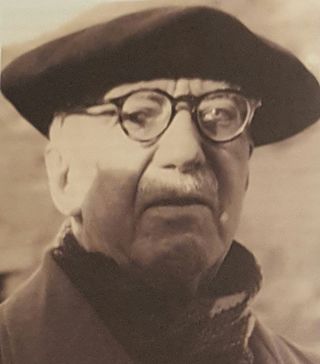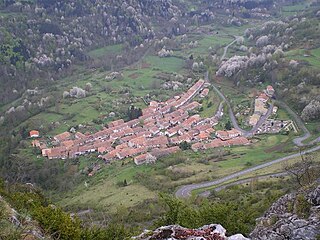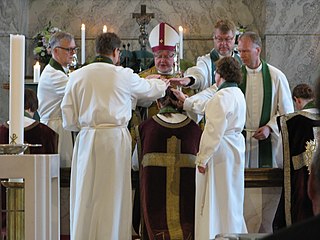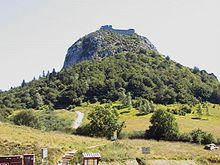Catharism was a Christian dualist or Gnostic movement between the 12th and 14th centuries which thrived in Southern Europe, particularly in northern Italy and southern France. Followers were described as Cathars and referred to themselves as Good Christians; in modern times, they are mainly remembered for a prolonged period of mutual conflict and religious persecution – widely regarded as genocide – by the Catholic Church which deemed Catharism a heretical sect.

Year 1244 (MCCXLIV) was a leap year starting on Friday of the Julian calendar.

The Albigensian Crusade or the Cathar Crusade was a military and ideological campaign initiated by Pope Innocent III to eliminate Catharism in Languedoc, what is now southern France. The Crusade was prosecuted primarily by the French crown and promptly took on a political aspect. It resulted in the significant reduction of practicing Cathars and a realignment of the County of Toulouse with the French crown. The distinct regional culture of Languedoc was also diminished.
Bogomilism was a Christian neo-Gnostic or dualist sect founded in the First Bulgarian Empire by the priest Bogomil during the reign of Tsar Peter I in the 10th century. It most probably arose in the region of Kutmichevitsa, today part of the region of Macedonia.

The Château de Montségur is a former fortress near Montségur, a commune in the Ariège department in southern France. Its ruins are the site of a razed stronghold of the Cathars. The present fortress on the site, though described as one of the "Cathar castles," is actually of a later period. It has been listed as a monument historique by the French Ministry of Culture since 1862.

Pierre de Castelnau, French ecclesiastic, made papal legate in 1199 to address the Cathar heresy, he was subsequently murdered in 1208. Following his death Pope Innocent III beatified him by papal order, excommunicated Count Raymond VI of Toulouse, and declared the Albigensian crusade.
Perfect was the name given by Bernard of Clairvaux to the leaders of the mediaeval Christian religious movement in southern France and northern Italy commonly referred to as the Cathars. The Perfecti were not clerics in any way, but merely members who had become 'adepts' in the teaching, and whose role was that of aiding other ordinary members achieve the rewards of belief and practice. The term reflects the fact that such a person was seen by the Catholic Church as the "perfect heretic". As "bonhommes", Perfecti were expected to follow a lifestyle of extreme austerity and renunciation of the world which included abstaining from eating meat and avoiding all sexual contact. They were thus recognized as trans-material angels by their followers, the Credentes. Perfecti were drawn from all walks of life and counted aristocrats, merchants and peasants among their number. Women could also become Perfecti and were known as Parfaites or Perfectae.

Antonin Gadal was a French mystic and historian who dedicated his life to study of the Cathars in the south of France, their spirituality, beliefs and ideology.

Cathar castles are a group of medieval castles located in the Languedoc region. Some had a Cathar connection in that they offered refuge to dispossessed Cathars in the thirteenth century. Many of these sites were replaced by new castles built by the victorious French Crusaders and the term Cathar castle is also applied to these fortifications despite their having no connection with Cathars. The fate of many Cathar castles, at least for the early part of the Crusade, is outlined in the contemporary Occitan "Chanson de la Croisade", translated into English as the "Song of the Cathar Wars ".
Heresy in Christianity denotes the formal denial or doubt of a core doctrine of the Christian faith as defined by one or more of the Christian churches.
Dualism in cosmology or dualistic cosmology is the moral or spiritual belief that two fundamental concepts exist, which often oppose each other. It is an umbrella term that covers a diversity of views from various religions, including both traditional religions and scriptural religions.

Montségur is a commune in the Ariège department in southwestern France.
Guilhabert de Castres was a prominent Cathar theologian. Born in Castres, he became a Cathar Perfect and, between 1223 and 1226, Bishop of Toulouse in the Cathar Church. In the theological debates in the early 13th century between the Cathars and the Papal representatives, he presented the Cathar arguments, including at the Debate at Montreal in 1206 and at the last Debate at Pamiers where he encountered Saint Dominic in 1207, prior to the Albigensian Crusades.

The siege of Montségur was a nine-month siege of the Cathar-held Château de Montségur by French royal forces starting in May 1243. After the castle surrendered, about 210 perfecti and unrepentant credentes were burned in a bonfire on 16 March 1244.

In Christianity, the laying on of hands is both a symbolic and formal method of invoking the Holy Spirit primarily during baptisms and confirmations, healing services, blessings, and ordination of priests, ministers, elders, deacons, and other church officers, along with a variety of other church sacraments and holy ceremonies.

The siege of Minerve was a military engagement which took place in June and July 1210 during the Albigensian Crusade in the town of Minerve in southern France. It was undertaken by the Catholic Crusaders against the Cathars in southern France, who were regarded as a heretical sect. The Crusaders, led by French nobleman Simon de Montfort, besieged and captured the town. The Crusaders allowed the soldiers defending the town, Catholics, and any Cathars who had not yet reached the status of perfect to go free. Three Cathar perfects who repented were pardoned, but 140 others who refused to do so were burnt at the stake.
The Book of the Secret Supper, also known as Interrogatio Iohannis, The Book of John the Evangelist and The Gospel of the Secret Supper was a Bogomil apocryphal text from Bulgaria, possibly based on a now lost Paulician treatise, which also became an important Cathar scripture. The book was translated into Latin and introduced to Italy in the late 12th century, then taken to Provence before the Albigensian Crusade by the Cathar bishop Nazarials or Nazario.
The Avignonet massacre occurred on the eve of 28 May 1242 when a small force, mainly consisting of Cathars, massacred a group of inquisitors during the Albigensian Crusade.










